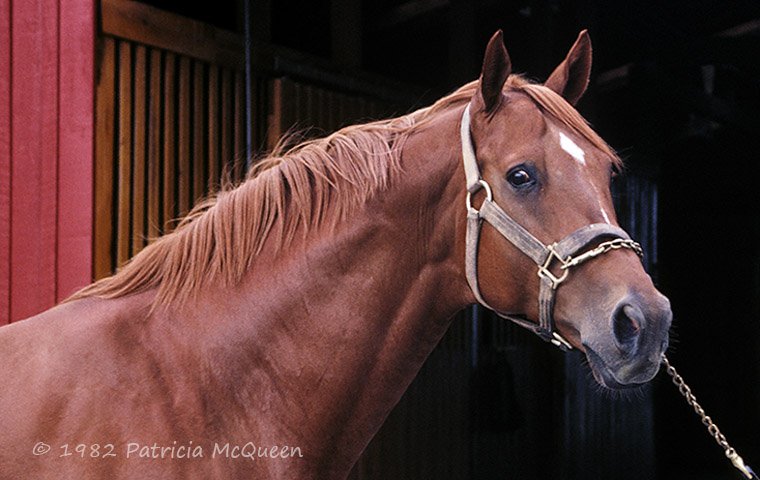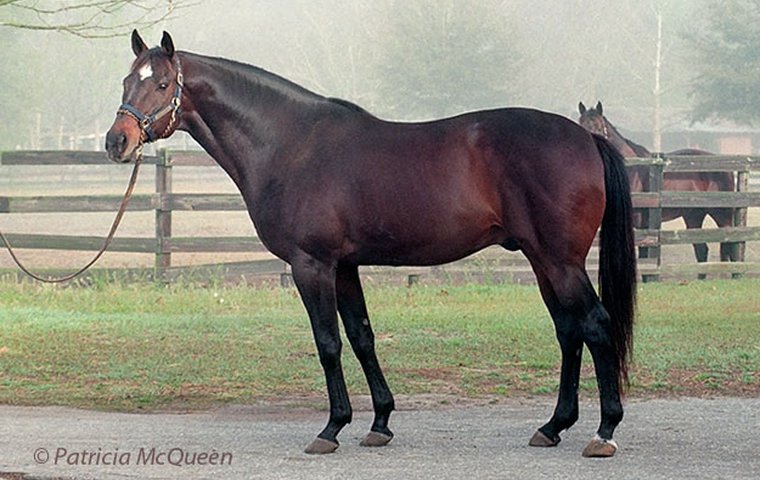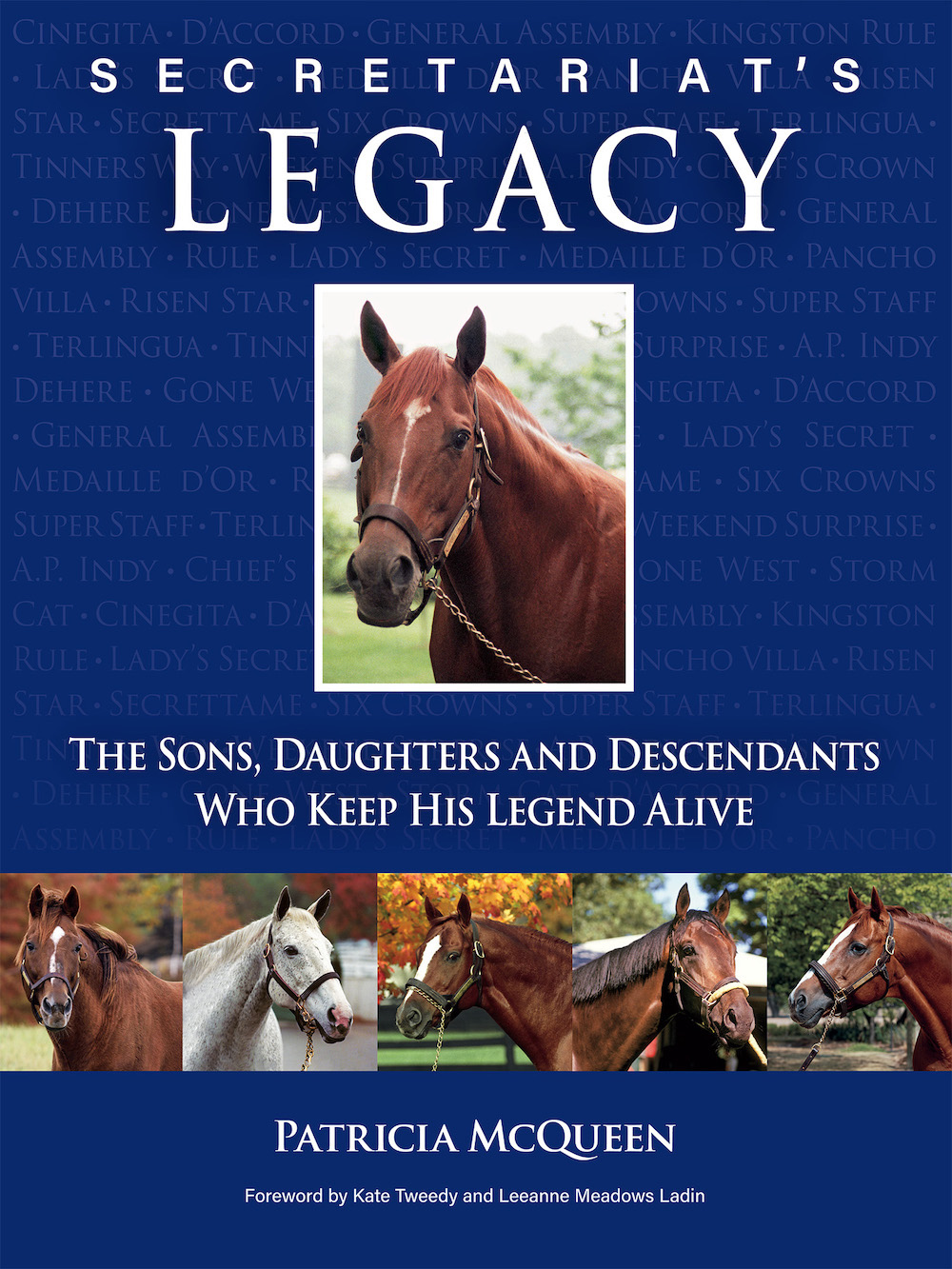
In the second of two articles looking at Secretariat’s successful stakes winners in Europe, Patricia McQueen concentrates on sons of the equine legend
While Secretariat’s first crop of foals was a disappointing lot when they hit the races in North America, with only two maiden winners to show for the 1977 season, a third youngster across the pond saved the year for the freshman stallion.
Dactylographer won the G1 William Hill Futurity at Doncaster, the richest two-year-old race in England to t
Dactylographer: a leading two-year-old in Britain in 1977, when he won the G1 William Hill Futurity. Photo: Patricia McQueen
hat time, concluding his campaign with two wins in three starts for trainer Peter Walwyn.Part 1: More than just a US phenomenon – how Secretariat’s daughters fared in Europe
Twenty years later, a chestnut son named Transcript won the Ericsson Gold Cup, a Listed race at Dielsdorf in Switzerland, to become the very last Secretariat to win a stakes race anywhere in the world; he was eight years old.
In those 20 years, four other sons of Secretariat won stakes races in Europe. The most accomplished of the group was Tinners Way who, before he became a multiple G1 winner on the dirt in America, won two turf stakes races in England. The others were Italian G2 winner Sifounas, Hungarian stakes winner Lease Back, and another Swiss runner, Sectori.
Both Dactylographer and Tinners Way were featured earlier in this series, so this article begins with Sifounas, a colt from Secretariat’s second crop.
Group success in Italy
Born February 12, 1976, the chestnut colt was bred in Kentucky by Ponjola Farm and Gerald Frankel. His dam was the Argentine-bred Trevisana, a winning full-sister to Forli, Argentina’s 1966 Horse of the Year.
That parentage, plus his good looks, brought $370,000 when the colt was sold as a weanling at the Keeneland November sale – smashing the world record of $250,000 set the year before by a first-crop son of Secretariat.
Sifounas (Greek for tornado) was sent to France, where he was trained by Francois Boutin for owner Walter Sommers. At Longchamp, Sifounas placed in both starts at two. Unplaced in his return to racing on April 1, 1979, the colt broke his maiden in his fourth start, taking a 2,000-metre maiden at Chantilly on June 7, with regular rider Philippe Paquet aboard.
Sifounas was knocking on the door in most of five more starts as a three-year-old, with three placings in France, including a third in stakes company at Longchamp. To end his season, Sifounas was sent to Italy looking for a stakes win, and was second in the G3 Premio Carlo Porta at Milan on October 27.
The colt had a limited campaign at four. He finished sixth in a race at Saint-Cloud on April 1, 1980, followed by a third at Maisons-Laffitte on April 25.
That set him up for another excursion to Italy, and this time the trip paid off handsomely with a G2 win to end his career in the Premio Ellington (now Premio Carlo d’Alessio) at Capannelle in Rome on May 9, when Sifounas became a Group-race winner with a three-length victory in the 2,400-meter event.
In total, Sifounas won two of 12 starts, with three seconds and four thirds, for earnings of $54,698. Purchased privately thereafter, he entered stud in 1981 at J. T. Lundy Farm in Kentucky. Like many sons of Secretariat, though, he didn’t make an impact as a sire, at least not with Thoroughbreds.
Eventually sent to California, he ended up having some success as a sire of show jumpers. The stallion died in 2000 at Daehling Ranch in Elk Grove, California.
Hungarian rewards
The powerhouse racing and breeding operation that is Juddmonte Farms raced Secretariat’s G1 winners Tinners Way and Super Staff, but they also sold off some Secretariats that didn’t show much promise in their early racing.
Children of Secretariat: Tinners Way, the son who gave the great horse his last hurrah
One such was Lease Back, a Kentucky-bred out of the Star Appeal mare Go Leasing, a G2 winner in England who had been purchased by Juddmonte as a broodmare.
Born in Kentucky on April 26, 1988, the chestnut colt made three starts at two in England for Khalid Abdullah, with only one second to show for his efforts. Offered for sale the next year, Lease Back was purchased by Hungarian interests.
He may not have fit into the racing program in the UK, but Lease Back was right at home in more shallow waters at Hungary’s historic Kincsem Park, where he was trained by Zakariás Aparianov and raced in the colors of Ba-Ra Stables.
Lease Back made his local debut on April 21, 1991, in the Parádi Díj at 1,600 metres on the turf. He dominated the small field of five, winning by 12 lengths. He repeated that performance on May 5, in the Zirci Díj at 1,800 meters, this time facing a field of eight. He won easily by 10 lengths.
Next came two of the most prestigious races in Hungary. First was the Millenniumi Díj on May 26 at 1,800 meters. In the seven-horse field, Lease Back won his third straight, but the margin was closer as he scoeed by a length and a quarter.
In what would be his final race, he faced his stiffest challenge yet in the Magyar Derby (Hungarian Derby) on June 30, featuring a full field of 14 horses over a distance of 2,400 meters. The Irish-bred Jeremy proved too much for Lease Back to handle, winning by seven lengths as Secretariat's son held second.
Sadly, Lease Back never got a chance to do more, as he died in August that year. Yet for a brief period of time, his performances brought reminders of his sire to an entirely new audience.
At home in Switzerland
The remaining two European stakes winners by Secretariat were both purchased at the Newmarket sales in England and, like Lease Back, neither had shown much in their early races.
Both were purchased by Swiss-based owner Arnold Furter, whose knack for picking horses for a purpose was evident with these two Secretariats.
The first was Sectori, a Kentucky-bred born May 2, 1979. His dam was the Irish-bred G3 placed winner Marie Curie, a daughter of Exbury, French Horse of the Year in 1963.
The chestnut colt was bred by Ferrans Stud, owned by German industrialist Dr. Herbert Schnapka. Coincidentally, the Kentucky land where he was born was purchased by Juddmonte just a few years later.
Sectori made six starts in England as a three-year-old, and the best he could do was a pair of seconds and a third. When the colt was offered for sale at Newmarket, Furter took him for £5,800. “I loved his parentage,” Furter recalled decades later, with Secretariat the sire and a stakes-producing dam.
For his new owner, Sectori provided a great return on his investment. In 1986, he placed in Austria’s Internationale St. Leger, and also raced in France and Germany. It was in Switzerland where he really excelled, however. There, he won several stakes, including two of the country’s most important races not just once, but twice.
One was the Grosser Preis von St. Moritz, the signature grand prix of the storied White Turf meet each February, run over a snow-covered frozen lake. Sectori won the 2,000-metre event in 1984 and 1985, demonstrating a clear affinity for the unique surface. Furter noted that to succeed on the frozen, snowy course, a horse has to have the underlying class, but also has to be a “well-rested and completely honest horse” who gives his best on any type of footing.
However, Sectori wasn’t just a snow specialist. On the grass, he also won the 2,475-metre Grand Prix Jockey Club at Dielsdorf in both 1984 and 1986. For his achievements, the media voted Sectori the 1984 Swiss Horse of the Year.
Arthritis put an end to his racing career, and Furter found a place for him at a stud in Czechoslovakia. Without a Group win to his credit, though, he didn’t have much of a chance with the ladies.
Remarkably, Furter found another Secretariat at Newmarket who would fulfil his destiny for the owner, nine years after he purchased Sectori. This time, it was a flashy chestnut colt named Transcript being offered by Juddmonte with only had second place to show for his three English starts.
Born March 30, 1989, he was the last foal of Devon Ditty, a brilliantly fast multiple G1 winner in England as a two-year-old. That meant Transcript was related to Tinners Way – Devon Ditty’s first foal was Devon Diva, who went on to produce Tinners Way for Juddmonte.
Furter thought Transcript would be a good miler, and might give him a win in the Gold Cup, a Listed race at Dielsdorf. The horse obliged – twice in fact – taking the Ericsson-sponsored Gold Cup in 1996 and again in 1997.
It was that second victory that made him the last Secretariat to win a stakes race, about a year after his close relation Tinners Way won the G1 Californian. At age eight, it also made him the oldest Secretariat to ever win a stakes race, edging out the seven-year-old Swoon, who won the 1985 San Marino Handicap at Santa Anita.
Transcript also placed in additional stakes races in Switzerland, won a race in France and also raced in Germany. The horse was actually injured in one of his first starts for Furter, struck into by another horse and still holding on to finish second.
While recovering at a veterinary hospital, the owner’s daughters fell in love with the gutsy horse. They weren’t sure he’d ever make it back to the races, but he healed both physically and mentally to give Furter the victories he so desperately wanted. Transcript was eventually gelded and in retirement became a family riding horse.
Other European stakes runners
Concluding this two-part look at the racing sons and daughters of Secretariat in Europe, nine more were stakes-placed – three in Ireland, two in England and four in France.
The standouts among them were the six fillies, because of what they accomplished later as broodmares. Lady Winborne, third in the G3 Brownstown Stakes in Ireland, went on to become one of Secretariat’s most important broodmares.
As did Celtic Assembly, stakes-placed in England; in addition to generations of top stakes winners through her daughters, her son Volksraad was one of the greatest stallions in New Zealand history.
Rosa Mundi was stakes-placed in Ireland, and her son Correggio earned the American Eclipse Award as champion steeplechaser in 1996.
Another son, Sword Dance, was a G2 winner in the US who went on to sire a few top runners.
Irish stakes-placed winner Clandestina was another Secretariat stakes producer, as her son Desert Secret was an English G2 winner. Her female line is responsible for several graded/group winners across the globe.
The Secretariat filly Girl Friday was second in a G3 event in Britain, and her female line has produced a number of Graded-stakes winners in Australia and New Zealand.
The lone stakes-placed Secretariat filly in France, American Feeling, didn’t have the producing success that the others did, although she did produce a Group-placed runner in Japan.
Among the three colts, all earned their stakes placings in France. Laughing Matter was second in the G3 Prix Gontaut-Biron, while Saronic was twice second in French stakes. And the only first-generation Secretariat to be stakes-placed over the jumps – anywhere – was Broadway Gold, second in the 1989 Prix de Pepinvast Hurdle.
… plus the Norwegian connection
While all these stakes horses and nearly 70 other Secretariats raced at least once in Europe, only one offspring of the Triple Crown winner raced in the Scandinavian countries.
Dagestan was a Kentucky-bred born in 1981, a bay colt out of the Bounteous mare Abergwaun; she was a top sprinter in England and Ireland in the early 1970s for the mighty Vincent O’Brien. At three, Dagestan was unplaced in one start in England before being sent to Norway. There, he made 50 starts through age six, with seven wins, six seconds and three thirds. He was also third in one start in Sweden.
Of course, there have also been numerous great descendants of Secretariat to race in Europe, and the ongoing impact of his grandsons in European pedigrees. Those might be stories for another day.
 Secretariat’s Legacy by Patricia McQueen can be ordered here for $54.95 at secretariatslegacy.com
Secretariat’s Legacy by Patricia McQueen can be ordered here for $54.95 at secretariatslegacy.com
More than just a US phenomenon: how Secretariat’s progeny fared in Europe
Last of the family line: catching up with Maritime Traveler, the only living son of Secretariat
Up close and personal at the court of king Secretariat – recalling one acolyte’s pilgrimage
‘Ol’ Border knew it was time’: farewell to the oldest known Secretariat, gone at 34
View the latest TRC Global Rankings for horses / jockeys / trainers / sires


